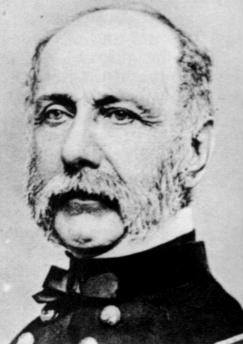James Barnes (general) facts for kids
James Barnes (born December 28, 1806 – died February 12, 1869) was an important person who managed railroads and later became a general in the Union Army during the American Civil War. He played a part in several major battles, showing bravery and leadership, especially early in his military career.
Quick facts for kids
James Barnes
|
|
|---|---|

James Barnes, photo taken during the 1860s
|
|
| Born | December 28, 1806 Boston, Massachusetts |
| Died | February 12, 1869 (aged 67) Springfield, Massachusetts |
| Place of burial |
Springfield Cemetery, Springfield, Massachusetts
|
| Allegiance | United States of America |
| Service/ |
United States Army Union Army |
| Years of service | 1829–1836, 1861–1866 |
| Rank | |
| Commands held | 18th Massachusetts Volunteer Infantry |
| Battles/wars | |
| Other work | Civil engineering |
Contents
Early Life and Career
James Barnes was born in Boston, Massachusetts. He went to the Boston Latin School and then to the United States Military Academy in 1829. This is a famous military school where future army leaders are trained. He was one of the top students in his class, finishing fifth out of 46 cadets.
After graduating, Barnes became a second lieutenant in the army. He spent most of his time teaching tactics and French at West Point. In 1832, he married Charlotte Adams Sanford. After his second son was born, he decided to leave the army in 1836. He became a civil engineer for railroads, which means he designed and built railway lines. By 1839, he was in charge of the Western Railroad, a job he held for 22 years.
Service in the Civil War
When the American Civil War began, Barnes returned to military service. On July 26, 1861, he became a colonel in the 18th Massachusetts Infantry. His regiment joined the Army of the Potomac, a major Union army.
Barnes and his troops were part of the Peninsula Campaign, but they did not see much fighting at first. During the Seven Days Battles, his regiment was on guard duty away from the main combat. In July 1862, he became the commander of a brigade, which is a group of several regiments.
Barnes's first real combat experience came during Lee's retreat after the Battle of Antietam. His brigade was attacked by Confederate soldiers, and many of his men were hurt or captured.
Battles and Promotions
At the Battle of Fredericksburg in December 1862, Barnes showed great courage. He led his brigade in an attack against strong Confederate positions. His commander praised him for his "coolness, energy, and marked ability." Because of his good performance, Barnes was promoted to brigadier general in April 1863.
In May 1863, Barnes's brigade fought at the Battle of Chancellorsville. He later took command of the 1st Division, a larger group of soldiers, when his division commander became ill.
The Battle of Gettysburg
The Battle of Gettysburg in July 1863 was the most important event in Barnes's military career. At 61 years old, he was one of the oldest Union generals there. His division arrived on the second day of the battle.
During a large Confederate attack, one of Barnes's brigades, led by Colonel Strong Vincent, was sent to defend a crucial spot called Little Round Top. This brigade fought very well and helped save the Union line. However, Barnes himself was not directly involved in that decision or the fighting there.
Barnes did lead his other two brigades into the Wheatfield, a very intense part of the battle. Here, his career took a difficult turn. He faced criticism for moving his troops back from the Wheatfield without permission. Later that day, Barnes was wounded in the leg. Although he recovered from the injury, he never returned to combat duty.
After his injury, Barnes spent the rest of the war on garrison duty, meaning he was in charge of guarding military posts in Virginia and Maryland. This included commanding the district that held a prisoner-of-war camp at Point Lookout, Maryland. He left the volunteer service in January 1866. He was also given the honorary rank of brevet major general for his service.
After the War
After the Civil War, James Barnes went back to his work as a railroad civil engineer. He was part of a government group that oversaw the building of the Union Pacific Railroad, a very important railway that connected the eastern and western parts of the United States.
James Barnes died in Springfield, Massachusetts, in 1869. He is buried in the Springfield Cemetery there.
See also
- List of American Civil War generals (Union)
- List of Massachusetts generals in the American Civil War
- 18th Regiment Massachusetts Volunteer Infantry
- Massachusetts in the American Civil War

